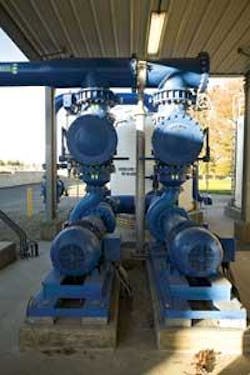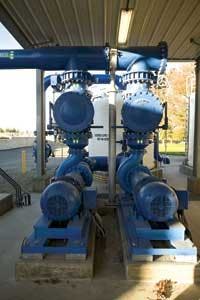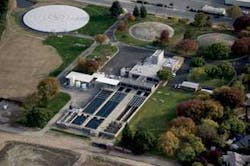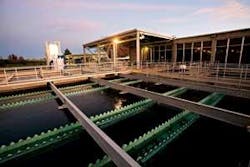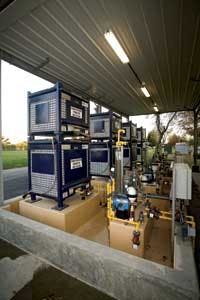Concurrent Operation of Conventional and Membrane Filtration During Plant Expansion
By Richard Stratton, Ian Pietz and John Westhouse
Yuba City, CA, had been experiencing increased water demands due to new development coupled with the need to replace low-quality groundwater systems that were purchased by the city. Water demand had been nearing the treatment plant's 24 mgd capacity, so a 12 mgd expansion was needed immediately.
The city's objective was to concurrently operate a new membrane system and conventional filters before ultimate conversion of the conventional filter to membranes. The expanded plant started operation in September 2007.
Utilities officials considered three options for expansion: constructing additional flocculation/sedimentation (F/S) basins and adding filters; constructing additional flocculation basins only and expanding with pressure membranes; and constructing additional flocculation basins only and expanding with submerged membranes.
The submerged membrane option was selected because it made the best use of the existing infrastructure, had the lowest capital and life-cycle costs, achieved low energy usage, offered the best planning for future regulatory impacts, and was most compatible with existing treatment processes. Membranes will be placed in the existing filter boxes for future expansions to achieve build-out capacity. Installing membranes in a filter box doubles the capacity compared to the output of a conventional filter.
Two submerged membrane system designs were included in the bid documents, with the USFilter/Memcor CMF-S (Siemens) system ultimately being selected by the contractor as the lowest overall cost. Competitive bidding included a present worth worksheet combined with overall project cost to establish the low bid. Pilot testing took place after membrane selection and prior to fabrication to confirm bid assumptions. Space for 10 percent extra modules was required as a factor of safety against unforeseen future water quality conditions.
Project Design Details
Project scope included installing a larger raw water source pipeline, implementing membrane filtration, and adding a 4 MG clearwell water storage tank, which doubled the plant's water storage capacity allowing for post chlorination. New fish screens for the intake were also designed, but construction of them has been deferred pending approval of funding for that project.
The new pretreatment-flocculation basins were designed to allow at least five minutes for coagulant reaction and flocculation to form pin flocs. The five-minute interval also provides adequate contact time for powdered activated carbon and allows heavy grit to settle. The existing sedimentation basins will be used during winter when higher turbidity is present but demand is lower.
The pretreatment system employs rapid mix using a submersible high-speed mixer. Dual flow band screening (2 mm) was designed to remove solids that may have passed through the flocculation basin or existing sedimentation basins. The flocculation basin and membrane basins operate on the same hydraulic grade line as the existing F/S basins and filters. The submerged membrane system was designed based on a flux of 31 gallons per square foot per day (gfd) and 97.5 percent overall recovery rate.
Project Challenges
The majority of challenges for concurrent operation of membrane and conventional filters were addressed during design. These challenges included limited space in the filter gallery, differing pre-treatment requirements, hydraulic compatibility including feed and backwash systems, and chemical feed compatibility.
Important factors to consider when retrofitting a submerged membrane include confirming the depth of the filter box for the membrane rack, confirming space available in the gallery for piping pumps, determining the inlet channel/piping hydraulics, determining the best option for backwash and clean-in-place (CIP) waste disposal, and checking compatibility of chemicals with membranes.
Specific issues identified during startup and one-year operation of the dual membrane and conventional filtration systems included:
- Frequent filter basin water level changes caused by membrane backwashes that make the control of conventional filters difficult,
- Polymers fed to conventional treatment that is incompatible with membranes,
- Insufficient backwash waste pumps that could not accommodate simultaneous backwashes of conventional and membrane filters.
The design team developed both short- and long-term solutions to feed channel issues. Short-term solutions included adding a throttle flow gate to the membrane flocculation basin, letting the membrane absorb the fluctuation, using level or flow control for the membrane filtration rate, and increasing response time and the control bandwidth of conventional filters to the changing water level in the feed channel.
Long term feed-channel solution included adding an automatic valve to control the flow to the membrane system. As more membrane trains are added, there will be less impact on conventional filters and the problem will be eliminated once the system is entirely converted to membrane filters for buildout conditions.
The short-term solution to backwash waste sump issues included fine-tuning the membrane backwash. It was deemed okay if the level was less than eight feet, or less than 14 feet and dropping. Otherwise, it would be held. The long-term solution was to upgrade waste pump capacity. Again, this will not be an issue after the system is fully converted to membrane treatment.
Initial operation of the brand new membrane system indicated that trans-membrane pressure (TMP) was limited to 1 to 2 psi and the permeate pump only needed to run at 30 percent of its capacity to get the designed flow. As is normal, the TMP increased slightly during the first year of operation to an average of 3 to 5 psi where it is holding steady. The operation and maintenance (O&M) costs for the membranes are projected to be approximately 5 percent less than conventional treatment due to chemical and labor savings. Power consumption is slightly higher for the membranes, but submerged membranes provided the lowest energy consumption of any of the pressure membrane systems.
Operational Observations After 18 Months
Implementing a 30-minute backwash interval with a longer interval (up to 55 minutes) for lower flows, allowed for improved system recovery and efficiency over a wide range of flows. A 96-hour interval was designed for caustic/hypochlorite maintenance wash, and a 40-day interval was developed for citric acid CIP. Fiber breakage to date has been limited and within specified criteria. The high quality membrane-filtered water blended with conventional filter effluent has improved the overall plant water quality output.
Adding membranes to the system produced some unexpected results. Discontinuing prechlorination led to biological growth in filter underdrain plates leading to increased headloss. A post F/S prefiltration chlorine feed point was added to address this problem.
Benefits of Using Dual Systems
Operating membranes and conventional filters offers several advantages. Membranes can operate without coagulants during the summer, and are able to better tolerate raw water turbidity spikes. During down times, the filters provide a backup to the membranes, and vice-versa. Membrane effluent is <0.05 NTU, reducing the combined filter NTU consistently to <0.10 NTU. Membrane effluent also has a lower chlorine demand, reducing chlorine use.
Conclusion
Keeping up with Yuba City's growing water demands was a top priority for the city, and the expansion project has added substantial capacity. The new membrane filters create a reliable system resulting in high-quality drinking water for Yuba City residents. —m
About the Authors:
Richard Stratton is located in HDR's Folsom, CA, office and is the HDR West Region Drinking Water Lead. Ian Pietz is a senior engineer with the city of Yuba City. John Westhouse is the plant supervisor with the city of Yuba City.
